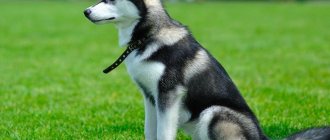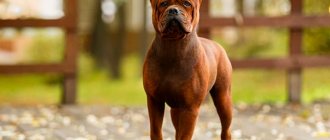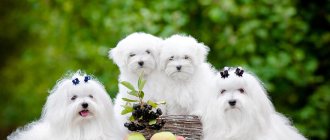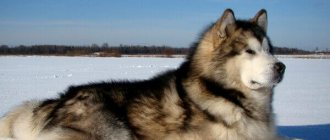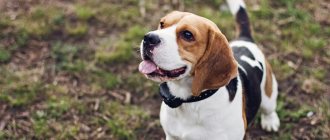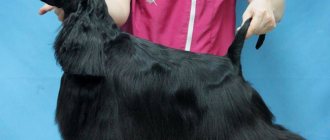Numerous “user instructions” flippantly state that the English greyhound is unpretentious in maintenance and requires minimal care. The section “ Beagle breed wool ” is usually devoted to two or three sentences. The ease of handling of a compact, short-haired dog does not in any way detract from the importance of the procedure.
Every beagle owner is sincerely interested in his pet being energetic, cheerful, beautiful and healthy. The coat is not only a natural “body armor” that protects the beagle from environmental influences, but the beagle’s fur coat is an excellent indicator of the animal’s health.
How to care for a beagle's coat
Wool is a protective layer that protects the animal's skin from environmental influences. The health of our pet depends on the state of this protection. But a dog’s healthy coat is not just an indicator of its health, it is one of its most important components. Proper coat care is no less important than a balanced diet and psychological comfort of your beagle.
Beagles are the type of dog that has a “regular coat,” or a medium-length coat (almost 80% of dogs in the world have this type of coat). This is a natural type of wool. It has its own peculiarity - from each follicular sac, in addition to the guard hair, several thin and almost colorless undercoat hairs grow, which are constantly renewed. The ducts of the sebaceous glands open into the follicular sacs. Their secretion - fat - covers the dog's skin and fur. The fat layer protects the wool from drying out and excess moisture, and has bactericidal properties. The hair grows to a certain length, dies and is pushed out of the hair follicle by new hair that replaces it. This process occurs continuously throughout the dog's body, which is why a healthy dog's coat looks uniform for most of the year.
Twice a year, dogs undergo a “massive” change of coat - shedding. This process is regulated by hormones and is associated with seasonal changes in ambient temperature and day length.
Beagles living in an apartment are characterized by unseasonal shedding; they need daily combing of the old undercoat for proper coat renewal. But if a dog sheds continuously, very profusely, this may be a symptom of some disease. It is better to consult a veterinarian on this issue. Poor nutrition and stress very quickly affect the quality and quantity of wool.
Don't believe the common myth that short-haired dogs require the least grooming. Any beagle owner will tell you that beagles shed a lot (!), their undercoat needs to be brushed regularly and their hair is very difficult to remove from clothes and furniture, because... Multi-colored beagle hairs are not always immediately noticeable.
What is grooming? - Regular brushing and washing. Actually nothing supernatural. In the very first days of molting, bathe the animal, followed by treatment with coat balm, and comb it thoroughly. After this procedure, the dog will still lose weight for a couple of days, but then it will become easier. And if during the entire molting period you can spend 10-15 minutes daily brushing your pet, the molting will be less stressful for both of you. Yes, and by relieving your pet of hair loss, you are helping him a lot by ensuring healthy skin.
Year-round shedding needs to be dealt with somewhat differently - this problem already lies in the veterinary field. Heavy shedding at the wrong time is a sign of a lack of important microelements in the body, which means a lack of nutritional balance. Typically, this problem is more acute among owners who feed their animals “naturally”.
Adherents of natural feeding should definitely include vitamin supplements in the food, but I would not get carried away with synthetic vitamins. An excellent remedy, in particular for dogs, is pollen. It contains everything a dog’s body needs, including hair. There is no calcium needed for bones; it is given to animals separately. By the way, kefir, cottage cheese, cookies - this is not food, it is an additive to food. Quite compatible with drying.
Causes of excessive shedding:
1. Wrong diet that is not suitable for this particular dog; 2. Lack or excess of vitamins; 3. Worms or other parasites, such as fleas; 4. Hormonal disorders; 5. Metabolic disorders; 6. Stress; 7. Allergy; 8. The temperature in the room where the dog lives is too high; 9. Incorrectly selected shampoo, conditioner or some cosmetics; 10. Washing too often.
Well, and a few more. Having found out the reason (sometimes you have to become a real Sherlock Holmes and use the deductive method), you will understand what needs to be done to reduce the amount of wool in the house.
Combing. furminator combs , which have recently appeared on sale in Russia, are best suited The Furminator is a tool for removing dead undercoat, developed in the USA by professional groomers. Its secret is in the special structure of the comb, which, without cutting the hair or damaging the guard hair, gently pulls out the dead undercoat, which makes combing extremely effective. In addition, when combing out the undercoat, the furminator evenly distributes the oil secreted by the skin throughout the hair, which makes the coat softer and healthier, and also gives it shine.
But when buying a furminator, be careful - as always, along with the original, cheap fakes have now appeared on the market. You should not buy at low prices, as you will not only not get the desired result, but you may also harm your pet.
After working with the Furminator, you can also use a natural hair brush to smooth the coat and give it shine. And for even greater shine, after brushing, wipe the beagle’s fur several times with a dry cloth cloth in the direction of hair growth.
In addition to the furminator, fine-toothed combs, rubber brushes (they can also be used as a washcloth when washing) and a hair comb (but they cut off hair) have worked well.
Smell
Along with Bloodhounds and Basset Hounds, Beagles have one of the strongest senses of smell . In 1950, John Paul Scott and John Fuller began a study of dog behavior that lasted 13 years.
Part of this study was to determine the olfactory sensitivity of different breeds of dogs. To do this, they placed a mouse in a one-acre field and noted the time it took the dog to find it. The Beagle found it in one minute, while the Fox Terrier took 14, and the Scottish Terrier did not find it at all.
Beagles perform better when scent searching on the ground than in the air. because of this, they were excluded from the mountain rescue teams, choosing in favor of the collie, which is more obedient and uses its eyesight in addition.
Wool theory
The coat of the classic British hound has not been subjected to selective “improvement”. The beagle's coat does not require special procedures such as trimming, and does not require complex grooming movements from the owner (twisting hair curlers, treating with anti-matt balm, etc.).
In all price lists of pet spa salons and grooming centers, beagle babies are classified in the “regular medium-length coat” category. No exotic or exclusive.
Beagles are natural and natural: from each follicular sac, in addition to the hard guard hair, thin fluffs of undercoat grow. The hair container is “tied” with sebaceous glands, the secreted fat moisturizes (lubricates) the dog’s skin and fur.
The hard awn and soft base of the undercoat constantly grow, reaching a certain length, die off (the cover is renewed). The process is continuous: the fur of a healthy dog looks shiny and evenly thick.
Twice a year, a “massive update” falls on the dog and its owner - seasonal beagle molting . The owner is struggling with contamination of home textiles, the dog is feeling unwell (the process is linked to hormonal levels).
History of the origin of the species
The exact origin of the Beagle has not been established, but one thing is certain - the purposeful breeding of these dogs for hunting originated in England during the founding of the aristocracy.
One theory is that the Greeks and Romans kept hunting dogs similar to the beagle. This was mentioned in the ancient Greek scripture “Onomasticon”, authored by Julius Pollux. Later, Celtic tribes brought them to the British Isles, where English breeders began to breed beagles as we know them today.
The small size made it possible to comfortably transport the dog even in a hunting pocket, and a group of these small pets could easily be placed in a special basket attached to the side of the horse.
The noble appearance and excellent hunting qualities immediately attracted the attention of the aristocratic stratum of society, and this became the reason for the mass breeding and strengthening of this breed in England. The first record of this dates back to 1475.
The beagle became more widespread in the 16th and 17th centuries, when people of average income could afford such a pet. This had a positive impact on the development of the breed: the dogs became not only a tool for hunters, but also the decorative pride of the yard. It was prestigious to own a dog with an interesting and unusual coloring. During this period, or more precisely in 1650, the English writer Bloom in his book described these dogs as the smallest of all that are used in hunting hares.
The second half of the 19th century was a period of decline in the popularity of this dog, but ardent lovers of hare hunting and admirers of the breed did not allow its complete disappearance; moreover, they revived it and raised it to a new level. Beagles began to participate in exhibitions and hunting trips. During this period, the first official Beagle lovers club was opened.
In our time, the breed has retained its popularity. In England, with their help, as in the old days, they are used to look for burrows of hares, and in other countries these dogs have become excellent companions and even assistants to customs officers. Thanks to their keen sense of smell, they can sense the presence of prohibited items.
Basic care procedures
The beagle's coat requires three basic actions:
- constant monitoring, visual inspection;
- thorough daily combing;
- washing (bathing) once every six months.
By examining the condition of the miniature dog’s fur, the owner takes care of the pet and shows the dog his sympathy and love. Beagles are wonderful empaths: positive energy and a warm emotional background have a beneficial effect on the animal’s body and stimulate the immune system.
Daily combing for 10-15 minutes removes dead hair and fluff, stimulates the functionality of the fat ducts, and improves blood circulation in the upper layers of the skin (combing is an excellent massage).
Bathing a hunting dog is an unnatural procedure: the use of detergents destroys the structure of the fur, has a bad effect on the dog’s skin, and provokes various dermatitis. In winter, beagles clean their coats on their own, lying in the snow. In summer, dogs enjoy swimming in open waters. When keeping an apartment (if it is heavily soiled), it is enough to wipe the beagle with a damp cloth. In standard situations, just wash your paws.
Feeding adult dogs
Ready-made feed
Switching to food for adult dogs. Monitor your pet's weight and stool condition. If there are deviations, reduce the serving size.
Natural nutrition
The diet is the same as for puppies. The daily amount of food should be 5% of the dog’s weight, divide it into 2 meals. Feed a pregnant or lactating bitch 3 times. per day, until lactation stops, include fermented milk products in your daily diet.
To clean teeth, you can give a little dry food or special bones from veins, as well as massive joints and calf tails. Adult beagles are very fond of offal - liver, heart, stomachs, etc.
Hair care during shedding period
Molting is a difficult life stage of a beagle . To solve the problem, a simple and uncomplicated procedure is enough: at the very start of the shedding process, the beagle is bathed, thoroughly dried, combed and treated with a special veterinary lotion. After the work has been carried out, the dog will still “lean in” for a couple of days, but the crisis will be overcome and the situation will stabilize.
Residential beagles are characterized by non-seasonal (chronic) shedding. Here bathing and lotions are powerless. If the daily loss of awns and downy undercoat becomes critically abundant ( the beagle sheds heavily ), a veterinarian's consultation is necessary; this state of affairs signals health problems.
Factors of excessive shedding:
- unbalanced diet;
- lack of minerals;
- helminths;
- stress;
- allergy;
- overheating of the dog;
- frequent washing.
Ectoparasites
Fleas, ticks and lice eaters not only cause itching and worsen the structure of the coat, but are also carriers of numerous pathologies. The pet industry offers beagle owners a wide range of products and drugs to combat parasites: collars, shampoos, sprays, solutions and veterinary drops.
For walks in nature and baiting game, experts recommend special “neck drops” for English hounds. Widespread and very popular preventive parfors have a bad effect on the legendary sense of smell of beagles and worsen the performance parameters of the magnificent bloodhound.
Tools
Furminator combs are well suited for grooming English hounds. The Furminator is an effective scraper for removing undercoat fluff. In addition to the pet innovation, to care for the coat of Beagle dogs using combs and massage brushes-mittens.
The main thing in the process is not the tool (although the convenience of the tools makes care easier), but the regularity and thoroughness of the procedure. Brushing removes dead hair and fluff, evenly distributes the fat secreted by the skin throughout the fur, making the dog’s coat soft, healthy and exquisitely shiny.
The well-groomed coat Beagle dog unobtrusively demonstrates to the world the social status of the charming English hound, informs everyone that the pet is healthy, happy and, most importantly, loved.
Care and happiness
Beagle sheds a lot, what should I do?
Training
The Beagle has a stubborn and freedom-loving character. These qualities of a dog significantly hinder the educational process. According to many dog handlers, you need to start training beagles from a very young age. In this breed, stubbornness is especially pronounced before one year of age. This is clearly visible.
Let's consider the most important points of training:
- The "carrot" method. It is important to remain patient during the training process. It’s a good idea to stock up on your favorite treats. As soon as the animal correctly performs a given command or act of obedience, reward it with a treat. There is no other way to come to an agreement with a dog;
- A categorical “No” to the “stick” method. A dog of this breed has a good memory and remembers for a long time any negativity associated with educational moments. It is not recommended to shout loudly at the dog, much less hit him. When doing the exercises, the beagle will remember his offense, and most likely, he may do the same.
Beagle coat care
Numerous “user instructions” flippantly state that the English greyhound is unpretentious in maintenance and requires minimal care. The section “beagle breed wool” is usually devoted to two or three sentences. The ease of handling of a compact, short-haired dog does not in any way detract from the importance of the procedure.
Every beagle owner is sincerely interested in his pet being energetic, cheerful, beautiful and healthy. The coat is not only a natural “body armor” that protects the beagle from environmental influences, but the beagle’s fur coat is an excellent indicator of the animal’s health.
What problems in everyday life may a beagle owner encounter?
Beagle is not the best guard for your home
If you want to use a beagle as a watchdog, then this is not a good idea. Their gentle nature and excessive friendliness are serious obstacles to attacking an intruder and protecting their home.
You can find damaged things at home
Beagle owners should also not leave the dog alone for a long time. They experience real anxiety from a long separation from their owner. This can lead her to destructive behavior. Out of boredom, she can look for entertainment on her own and come up with different ways to attract attention. And that means she will need to chew or dig for something.
It takes a lot of time to train a beagle.
Despite their friendly nature and cheerful nature, beagles are quite stubborn. Therefore, to train them, you need to be patient. First of all, these dogs need to be taught obedience and the commands “Come to me!”, “Place”, “Nearby”, “No”. For completing them, do not forget to reward the dog with food and kind words. To maintain the animal’s interest in training, you need to dilute it with games. But be firm and consistent in your actions, do not give any concessions to the dog. Only in this case will he recognize your authority and begin to obey.
Experienced trainers say that training a dog at home can take about a year before it begins to obey all commands and obey perfectly. If you don't want to spend that much time, take the puppy to a dog trainer. After training with him, the dog will learn to go to the litter box, will not hide things, ask for food from your hands, and will begin to treat you with respect.
Beagles are quite noisy
Another thing to remember is that these dogs don't just make loud barks, they make actual noise. There are three types of sounds that beagles can make: the bark, the howl, and the half-howl and half-bark sound they use when hunting when they see their prey. You can get used to it, but you need to be prepared. Therefore, if you have not very friendly neighbors, you should make sure that there are no problems in your relationship with them because of your puppy.
Wool theory
The coat of the classic British hound has not been subjected to selective “improvement”. The beagle's coat does not require special procedures such as trimming, and does not require complex grooming movements from the owner (twisting hair curlers, treating with anti-matt balm, etc.).
In all price lists of pet spa salons and grooming centers, beagle babies are classified in the “regular medium-length coat” category. No exotic or exclusive.
Beagles are natural and natural: from each follicular sac, in addition to the hard guard hair, thin fluffs of undercoat grow. The hair container is “tied” with sebaceous glands, the secreted fat moisturizes (lubricates) the dog’s skin and fur.
The hard awn and soft base of the undercoat constantly grow, reaching a certain length, die off (the cover is renewed). The process is continuous: the fur of a healthy dog looks shiny and evenly thick.
Basic care procedures
The beagle's coat requires three basic actions:
- constant monitoring, visual inspection;
- thorough daily combing;
- washing (bathing) once every six months.
By examining the condition of the miniature dog’s fur, the owner takes care of the pet and shows the dog his sympathy and love. Beagles are wonderful empaths: positive energy and a warm emotional background have a beneficial effect on the animal’s body and stimulate the immune system.
Daily combing for 10-15 minutes removes dead hair and fluff, stimulates the functionality of the fat ducts, and improves blood circulation in the upper layers of the skin (combing is an excellent massage).
Bathing a hunting dog is an unnatural procedure: the use of detergents destroys the structure of the fur, has a bad effect on the dog’s skin, and provokes various dermatitis. In winter, beagles clean their coats on their own, lying in the snow. In summer, dogs enjoy swimming in open waters. When keeping an apartment (if it is heavily soiled), it is enough to wipe the beagle with a damp cloth. In standard situations, just wash your paws.
Hair care during shedding period
Shedding is a difficult life stage for a beagle. To solve the problem, a simple and uncomplicated procedure is enough: at the very start of the shedding process, the beagle is bathed, thoroughly dried, combed and treated with a special veterinary lotion. After the work has been carried out, the dog will still “lean in” for a couple of days, but the crisis will be overcome and the situation will stabilize.
Residential beagles are characterized by non-seasonal (chronic) shedding. Here bathing and lotions are powerless. If the daily loss of awns and downy undercoat becomes critically abundant (the beagle sheds heavily), consultation with a veterinarian is necessary; this state of affairs signals health problems.
Factors of excessive shedding:
- unbalanced diet;
- lack of minerals;
- helminths;
- stress;
- allergy;
- overheating of the dog;
- frequent washing.
Ectoparasites
Fleas, ticks and lice eaters not only cause itching and worsen the structure of the coat, but are also carriers of numerous pathologies. The pet industry offers beagle owners a wide range of products and drugs to combat parasites: collars, shampoos, sprays, solutions and veterinary drops.
For walks in nature and baiting game, experts recommend special “neck drops” for English hounds. Widespread and very popular preventive parfors have a bad effect on the legendary sense of smell of beagles and worsen the performance parameters of the magnificent bloodhound.
Tools
Furminator combs are well suited for grooming English hounds. The Furminator is an effective scraper for removing undercoat fluff. In addition to the pet innovation, it is convenient and easy to care for the coat of Beagle dogs using combs and massage brushes-mittens.
The main thing in the process is not the tool (although the convenience of the tools makes care easier), but the regularity and thoroughness of the procedure. Brushing removes dead hair and fluff, evenly distributes the fat secreted by the skin throughout the fur, making the dog’s coat soft, healthy and exquisitely shiny.
The well-groomed coat of a Beagle dog unobtrusively demonstrates to the world the social status of the charming English hound, informs everyone that the pet is healthy, happy and, most importantly, loved.
If you find an error, please select a piece of text and press Ctrl + Enter.
Diseases and treatment
Beagles are long-lived dogs. If you take good care of it and follow the necessary recommendations, this dog breed will delight your family with its friendly disposition for up to 10 years. Even such an active dog can develop diseases, since they are classified as a “refined” breed.
The most common canine diseases in beagles are achondroplasia and hip dysplasia in the joints:
- Bone dysplasia. This bone disease occurs in older dogs, after about 8 years of age. May cause other diseases. This could be, for example, lameness;
- Achondroplasia. The disease is transmitted through the maternal line. Most often this is expressed in improper development of bone material. This disease can be detected by growth underdevelopment in the first year.
Relationships with other animals
Dogs of this breed can be great friends with other breeds. They can be friends with both dogs and other types of animals, for example, cows and horses. But there is rarely friendship with a cat family. The beagle perceives cats as willing prey. True, in some cases you can see an idyll. Although the Beagle breed is friendly to many people, this pet’s jaws are still very powerful. Other pets, for example, hamsters, guinea pigs, rats and other small animals, have experienced this more than once.
Currently reading:
- The American Cocker Spaniel is an adroit hunter and loyal friend.
- Seven Signs and Remedies for Getting Rid of Fleas in Dogs
- Is it worth it or not to include natural food in your dog’s diet?
- Tips for proper dog burial
How to care for a beagle's coat
Wool is a protective layer that protects the animal's skin from environmental influences. The health of our pet depends on the state of this protection. But a dog’s healthy coat is not just an indicator of its health, it is one of its most important components. Proper coat care is no less important than a balanced diet and psychological comfort of your beagle.
Beagles are the type of dog that has a “regular coat,” or a medium-length coat (almost 80% of dogs in the world have this type of coat). This is a natural type of wool. It has its own peculiarity - from each follicular sac, in addition to the guard hair, several thin and almost colorless undercoat hairs grow, which are constantly renewed. The ducts of the sebaceous glands open into the follicular sacs. Their secretion - fat - covers the dog's skin and fur. The fat layer protects the wool from drying out and excess moisture, and has bactericidal properties. The hair grows to a certain length, dies and is pushed out of the hair follicle by new hair that replaces it. This process occurs continuously throughout the dog's body, which is why a healthy dog's coat looks uniform for most of the year.
Twice a year, dogs undergo a “massive” change of coat - shedding. This process is regulated by hormones and is associated with seasonal changes in ambient temperature and day length.
Beagles living in an apartment are characterized by unseasonal shedding; they need daily combing of the old undercoat for proper coat renewal. But if a dog sheds continuously, very profusely, this may be a symptom of some disease. It is better to consult a veterinarian on this issue. Poor nutrition and stress very quickly affect the quality and quantity of wool.
Don't believe the common myth that short-haired dogs require the least grooming. Any beagle owner will tell you that beagles shed a lot (!), their undercoat needs to be brushed regularly and their hair is very difficult to remove from clothes and furniture, because... Multi-colored beagle hairs are not always immediately noticeable.
What is grooming? - Regular brushing and washing. Actually nothing supernatural. In the very first days of molting, bathe the animal, followed by treatment with coat balm, and comb it thoroughly. After this procedure, the dog will still lose weight for a couple of days, but then it will become easier. And if during the entire molting period you can spend 10-15 minutes daily brushing your pet, the molting will be less stressful for both of you. Yes, and by relieving your pet of hair loss, you are helping him a lot by ensuring healthy skin.
Breed characteristics
| Short description | |
| Origin: | England |
| Conditions of detention: | In a house without a garden, in a house with a large garden, in a house with a small garden, in an apartment |
| Purpose: | Hunting dog, companion dog, search dog |
| Color: | Tri-color (an arbitrary mixture of white, red and black), bicolor (white-red in different shades from red to lemon) and single-color (white) |
| Wool length: | Short |
| Adult dog size: | The height of females is 33-38 cm, the height of males is 36-41 cm, the weight of females is 9-10 kg, the weight of males is 10-14 kg |
| Average life expectancy: | 11-15 years |
| Walk: | Required at least 2 times a day |
| Physical activity needs: | High physical activity needs (regular or daily exercise for more than 3 hours per day) |
| Fédération Cynologique Internationale (FIC) classification: | Group 6. Hounds and related breeds, section 1. Hounds, subsection 1.3 small hounds, number 161, year 1955, with working test |
| Puppy price: | 10000-50000 rubles |

